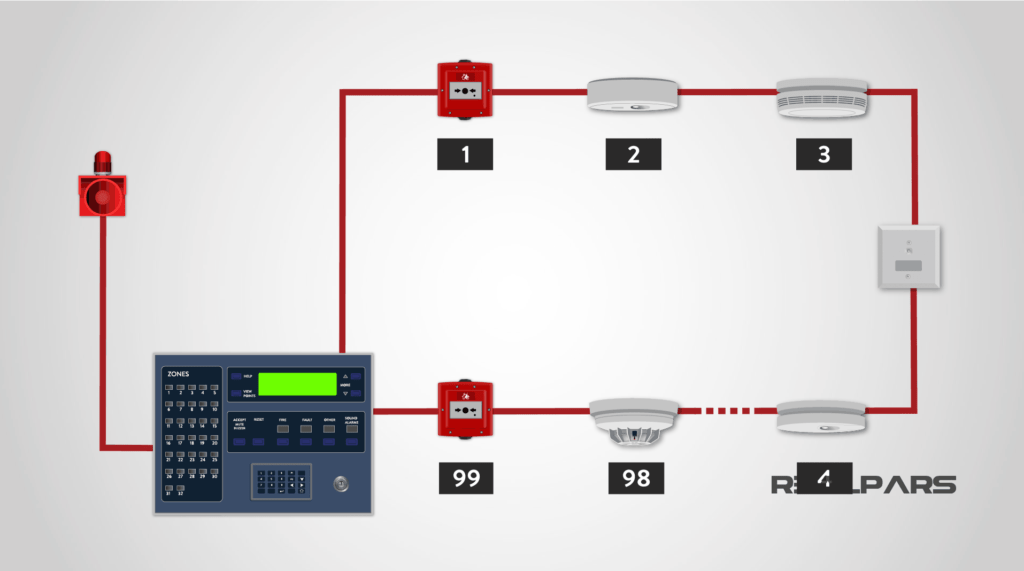Understanding the Basics of Fire Alarm Systems
Fire alarm systems are crucial for protecting lives and property. These systems detect fires early, alert people to danger, and often notify emergency services automatically. Let’s explore the key aspects of fire alarm systems and why they’re so important for fire safety.
What is a Fire Alarm System?

A fire alarm system is a network of devices that work together to detect fires and warn people of danger. It’s a vital part of fire protection in buildings. The main job of a fire alarm system is to spot fires quickly and let people know they need to leave the building.
Key Components of Fire Detection
- Smoke detectors: These sense smoke particles in the air.
- Heat detectors: They spot sudden temperature increases.
- Manual pull stations: People can use these to trigger the alarm if they see a fire.
- Control panel: This is the brain of the system, monitoring all devices.
- Alarm devices: These include sirens, flashing lights, and voice messages.
How Fire Alarm Systems Help with Fire Prevention
While fire alarm systems mainly detect fires, they also play a role in fire prevention:
- Early warning: Quick detection can stop small fires from growing.
- Regular testing: This helps find and fix potential fire hazards.
- Awareness: Having visible alarms reminds people to be careful with fire.
The Importance of Fire Safety
Fire safety is about protecting lives and property. A good fire alarm system is just one part of a complete fire safety plan. Other important steps include:
- Having fire extinguishers and knowing how to use them
- Planning and practicing escape routes
- Keeping exits clear
- Proper storage of flammable materials
Maintaining Your Fire Alarm System
To keep your fire alarm system working well:
- Test it regularly
- Replace batteries in battery-operated devices
- Clean detectors to prevent false alarms
- Have a professional inspect the system yearly
By understanding and properly maintaining fire alarm systems, we can all contribute to better fire protection and safety in our homes and workplaces.
Types of Fire Alarm Systems: Conventional vs. Addressable

Fire alarm systems come in two main types: conventional and addressable. Each has its own features and benefits. Understanding the difference can help you choose the right system for your needs.
Conventional Fire Alarm Systems

Conventional systems are simpler and often used in smaller buildings. Here’s how they work:
- Zones: The building is divided into zones.
- Detection: When a detector or pull station activates, it triggers the whole zone.
- Fire Alarm Panel: It shows which zone has the alarm, but not the exact device.
- Wiring: Each zone has its own circuit.
Pros:
- Simpler to install and maintain
- Less expensive for small areas
- Easy to use
Cons:
- Less precise location information
- Harder to manage in large buildings
Addressable Fire Alarm Systems

Addressable systems are more advanced and often used in larger buildings. Here’s how they work:
- Individual Addresses: Each device has a unique address.
- Fire Alarm Control Panel: It can pinpoint the exact device that triggered the alarm.
- Communication: Devices send detailed status info to the panel.
- Wiring: Uses a loop system, which can be more efficient.
Pros:
- Precise alarm location
- Easier to manage in large buildings
- Can provide more detailed information
- Often require less wiring
Cons:
- More complex to install and program
- Usually more expensive initially
Key Components in Both Systems
While the systems differ, they share some common fire alarm components:
- Detectors (smoke, heat, etc.)
- Manual pull stations
- Fire alarm panel or fire alarm control panel
- Alarm devices (sirens, strobes)
- Power supplies
Choosing the Right System
When deciding between conventional and addressable systems, consider:
- Building size and layout
- Budget
- Need for detailed information
- Future expansion plans
Both types of fire alarm systems can provide effective fire protection. The best choice depends on your specific needs and circumstances. Always consult with a fire safety professional when selecting and installing a fire alarm system.
Exploring Addressable Fire Alarm Systems in Detail

Addressable fire alarm systems represent the cutting edge of fire detection technology. These systems offer enhanced precision, control, and information compared to conventional systems. Let’s dive deeper into how they work and their key components.
How Addressable Fire Alarm Systems Work
- Unique Identification: Each device in an addressable system has its own “address” or ID number.
- Continuous Communication: Devices constantly send status updates to the control panel.
- Precise Location: When an alarm triggers, the panel knows exactly which device activated.
- Intelligent Decision Making: The system can use data from multiple devices to confirm a fire.
Key Components of an Addressable Fire Alarm System
- Addressable Fire Alarm Panel
- Acts as the system’s brain
- Monitors all connected devices
- Processes information and decides when to trigger alarms
- Can be programmed for different responses based on input
- Addressable Fire Alarm Devices
- Smoke detectors
- Heat detectors
- Manual pull stations
- Input/output modules (for connecting to other building systems)
- Addressable Fire Alarm Sensors
- More sophisticated than conventional sensors
- Can adjust sensitivity based on environment
- May include multi-criteria sensors (combining smoke, heat, and CO detection)
- Communication Loop
- Connects all devices to the panel
- Can support hundreds of devices on a single loop
- Often uses a “Class A” wiring method for added reliability
Advantages of Addressable Systems
- Precise Fire Location: Pinpoints exact device that triggered, speeding up response.
- Reduced False Alarms: Smart sensors and confirmation from multiple devices help prevent false alarms.
- Early Warning: Can detect potential issues before they become fires.
- Easier Maintenance: System can identify devices needing attention.
- Flexible Programming: Can set up complex cause-and-effect scenarios.
- Scalability: Easy to add or remove devices as needed.
Considerations When Installing an Addressable System

- Initial Cost: Generally more expensive upfront than conventional systems.
- Complexity: Requires more skilled technicians for installation and programming.
- Training: Staff may need more training to use advanced features effectively.
- Compatibility: Ensure all components are compatible with the chosen panel.
Future of Addressable Fire Alarm Systems
Addressable systems continue to evolve, with trends including:
- Integration with other building systems (HVAC, security, etc.)
- Cloud connectivity for remote monitoring and management
- Advanced analytics to predict potential fire risks
- Improved user interfaces for easier operation
Addressable fire alarm systems offer powerful capabilities for fire detection and building safety. While they require more initial investment and expertise, they provide superior protection and control, especially in larger or more complex buildings.
The Importance of Regular Fire Alarm Testing and Maintenance

A fire alarm system is only effective if it’s working properly. Regular testing and maintenance are crucial to ensure your system functions correctly when you need it most. Let’s explore why this is so important and what it involves.
Why Regular Testing and Maintenance Matter
- Safety: Ensures the system will work in an emergency, potentially saving lives.
- Legal Compliance: Many areas require regular fire alarm inspection by law.
- Early Problem Detection: Catches issues before they lead to system failure.
- Cost Savings: Prevents expensive repairs or replacements due to neglect.
- Insurance Requirements: Many insurers require proof of regular maintenance.
Fire Alarm Testing: What’s Involved?
- Visual Inspection:
- Check for physical damage to devices
- Ensure detectors are unobstructed
- Verify indicator lights are working
- Functional Tests:
- Activate manual pull stations
- Test smoke and heat detectors
- Check audible and visual alarms
- Verify signal transmission to monitoring station
- Battery Check:
- Test backup batteries
- Replace as needed (usually every 3-5 years)
- Panel Functions:
- Test control panel operations
- Verify zone information is correct
Fire Alarm System Maintenance
- Cleaning:
- Remove dust from detectors
- Clean alarm covers
- Sensitivity Adjustments:
- Check and adjust detector sensitivity if needed
- Software Updates:
- Update system software if applicable
- Component Replacement:
- Replace worn or outdated parts
Fire Alarm Code Compliance
- Know Local Codes:
- Familiarize yourself with local fire safety regulations
- Understand required testing frequencies
- Documentation:
- Keep detailed records of all tests and maintenance
- Have these available for fire marshals or inspectors
- Professional Inspections:
- Schedule required professional inspections
- Address any issues found promptly
Fire Alarm System Troubleshooting
Common issues and solutions:
- False Alarms:
- Clean detectors
- Check for nearby sources of smoke or steam
- Verify proper detector type for the location
- System Won’t Reset:
- Check for stuck pull stations
- Verify all detectors are clear
- Check for wiring issues
- Battery Problems:
- Replace weak or dead batteries
- Check for corrosion on battery connections
- Communication Failures:
- Check phone lines or network connections
- Verify monitoring station information is correct
Frequency of Testing and Maintenance
While specific requirements may vary, a general schedule might include:
- Weekly: Check panel status
- Monthly: Test manual pull stations and alarm devices
- Quarterly: Test smoke detectors
- Annually: Full system inspection by a professional
Remember, these are general guidelines. Always follow manufacturer recommendations and local fire codes for your specific system.
By prioritizing regular fire alarm testing and maintenance, you ensure your system remains reliable, compliant, and ready to protect lives and property when needed.
Best Practices for Effective Fire Alarm System Testing

Proper testing of fire alarm systems is crucial for ensuring they function correctly in emergencies. Following these best practices will help maintain system reliability and code compliance.
Develop a Comprehensive Testing Plan
- Create a schedule covering all system components
- Include both visual inspections and functional tests
- Align with manufacturer guidelines and local fire codes
- Assign responsibilities to specific team members
Follow Proper Fire Alarm Testing Procedures
- Start with a visual inspection of all devices
- Test one device at a time to pinpoint any issues
- Verify each device activates correctly
- Check that the control panel receives and displays correct information
- Test all notification appliances (horns, strobes, voice systems)
Conduct Regular System Inspections
- Daily: Check control panel for normal operation
- Weekly: Test one manual pull station
- Monthly: Inspect all batteries and power supplies
- Quarterly: Test a sampling of initiating devices (smoke detectors, heat sensors)
- Annually: Complete full system test and professional inspection
Maintain Detailed Records
- Document all tests, inspections, and maintenance activities
- Record date, time, and results of each test
- Note any deficiencies found and corrective actions taken
- Keep records accessible for fire marshals and insurance inspectors
Address Fire Alarm System Maintenance Needs Promptly
- Replace batteries as needed (typically every 3-5 years)
- Clean smoke detectors to prevent false alarms
- Update system software when available
- Replace any damaged or malfunctioning components immediately
Stay Current with Fire Alarm Code Requirements
- Regularly review local and national fire codes
- Attend training sessions on code updates
- Ensure your testing procedures meet or exceed code requirements
Use Proper Testing Equipment
- Invest in calibrated testing tools for smoke and heat detectors
- Use manufacturer-approved testing sprays and equipment
- Maintain and calibrate testing equipment regularly
Minimize Disruptions During Testing
- Notify building occupants before testing
- Consider conducting tests during off-hours
- Use the system’s “test mode” to prevent false dispatches to fire departments
Train Personnel Properly
- Ensure all testing staff are properly trained
- Provide regular refresher courses
- Keep staff updated on system changes and new technologies
Coordinate with Monitoring Services
- Notify monitoring station before and after testing
- Verify signals are received correctly at the monitoring station
- Test backup communication methods
Conduct Periodic Full-Scale Tests
- Annually perform a complete system test
- Simulate various fire scenarios
- Verify integration with other building systems (HVAC, elevators, etc.)
Review and Improve
- After each test, review results and procedures
- Identify areas for improvement in the system or testing process
- Update testing plans based on findings
By following these best practices, you can ensure your fire alarm system testing is thorough, effective, and compliant with fire alarm code requirements. Remember, regular and proper testing is key to maintaining a reliable fire alarm system that will perform when it’s needed most.
Conclusion: Ensuring the Safety of Your Facility with a Reliable Fire Alarm System
Fire alarm systems play a crucial role in protecting lives and property. As we’ve explored throughout this article, understanding, maintaining, and properly testing these systems is vital for ensuring their effectiveness when it matters most.
Key Takeaways from this article:
- System Understanding: Knowing the basics of fire alarm systems, including the differences between conventional and addressable systems, helps in choosing the right solution for your facility.
- Regular Maintenance: Consistent upkeep is essential for system reliability. This includes routine checks, cleaning, and timely replacement of components.
- Thorough Testing: Following best practices for fire alarm testing ensures all parts of the system function correctly and meet code requirements.
- Code Compliance: Staying up-to-date with fire alarm code requirements is crucial for legal compliance and optimal safety.
- Professional Involvement: While many aspects of fire alarm system maintenance can be handled in-house, professional inspections and servicing are essential for comprehensive safety.
- Continuous Improvement: As technology advances, so do fire alarm systems. Regularly assess your system to see if upgrades could enhance your facility’s safety.
- Staff Training: Ensure that your team understands how to respond to alarms and how to perform basic system checks.
Remember, a fire alarm system is more than just a legal requirement or a box to check off – it’s a critical life-safety system. By investing time and resources into your fire alarm system, you’re investing in the safety of everyone who enters your facility.
The peace of mind that comes with a well-maintained, reliable fire alarm system is invaluable. It allows you to focus on your core business activities, knowing that you’ve taken important steps to protect your people, property, and assets from the threat of fire.
In conclusion, fire safety is an ongoing commitment. By staying informed, vigilant, and proactive in your approach to fire alarm systems, you create a safer environment for all. Your dedication to fire safety today could save lives tomorrow.







